Microstructural Evolution along the NiCrMoV Steel Welded Joints Induced by Low-Cycle Fatigue Damage
Abstract
1. Introduction
2. Materials and Methods
3. Results and Discussion
3.1. The Low-Cycle Fatigue Tests
3.2. Tensile Tests
3.3. Hardness Measurements
3.4. Microstructural Observation by TEM
3.5. The Difference of Cyclic Softening Mechanisms in BM and WM
4. Conclusions
Author Contributions
Funding
Institutional Review Board Statement
Informed Consent Statement
Data Availability Statement
Conflicts of Interest
References
- Shao, C.; Zhang, P.; Zhang, Z.; Zhang, Z. Butterfly effect in low-cycle fatigue: Importance of microscopic damage mechanism. Scr. Mater. 2017, 140, 76–81. [Google Scholar] [CrossRef]
- Du, C.C.; Hoefnagels, J.J.; Vaes, R.R.; Geers, M.M. Plasticity of lath martensite by sliding of substructure boundaries. Scr. Mater. 2016, 120, 37–40. [Google Scholar] [CrossRef]
- Xue, P.; Wang, B.; An, X.; Ni, D.; Xiao, B.; Ma, Z. Improved cyclic softening behavior of ultrafine-grained Cu with high microstructural stability. Scr. Mater. 2019, 166, 10–14. [Google Scholar] [CrossRef]
- Höppel, H.W.; Zhou, Z.M.; Mughrabi, H.; Valiev, R.Z. Microstructural study of the parameters governing coarsening and cyclic softening in fatigued ultrafine-grained copper. Philos. Mag. 2009, 82, 1781–1794. [Google Scholar] [CrossRef]
- Konovalov, S.; Komissarova, I.; Ivanov, Y.; Gromov, V.; Kosinov, D. Structural and phase changes under electropulse treatment of fatigue-loaded titanium alloy VT1-0. J. Mater. Res. Technol. 2019, 8, 1300–1307. [Google Scholar] [CrossRef]
- Konovalov, S.; Ivanov, Y.; Gromov, V.; Panchenko, I. Fatigue-Induced Evolution of AISI 310S Steel Microstructure after Electron Beam Treatment. Materials 2020, 13, 4567. [Google Scholar] [CrossRef] [PubMed]
- Hu, X.; Huang, L.; Wang, W.; Yang, Z.; Sha, W.; Wang, W.; Yan, W.; Shan, Y. Low cycle fatigue properties of CLAM steel at room temperature. Fusion Eng. Des. 2013, 88, 3050–3059. [Google Scholar] [CrossRef]
- Barrett, R.A.; O’Donoghue, P.E.; Leen, S.B. A physically-based constitutive model for high temperature microstructural deg-radation under cyclic deformation. Int. J. Fatigue 2017, 100, 388–406. [Google Scholar] [CrossRef]
- Stanford, N.; Wang, J.; Hilditch, T. Quantification of strain partitioning during low cycle fatigue of multi-phase steels con-taining a bainite matrix. Int. J. Fatigue 2019, 129, 105218. [Google Scholar] [CrossRef]
- Zhou, Q.; Qian, L.; Meng, J.; Zhao, L.; Zhang, F. Low-cycle fatigue behavior and microstructural evolution in a low-carbon carbide-free bainitic steel. Mater. Des. 2015, 85, 487–496. [Google Scholar] [CrossRef]
- Adamczyk-Cieślak, B.; Koralnik, M.; Kuziak, R.; Brynk, T.; Zygmunt, T.; Mizera, J. Low-cycle fatigue behaviour and micro-structural evolution of pearlitic and bainitic steels. Mater. Sci. Eng. A 2019, 747, 144–153. [Google Scholar] [CrossRef]
- Wang, C.; Xuan, F.-Z.; Zhao, P. A dislocation-based constitutive model for the cyclic response of nanolath strengthened steels. Int. J. Mech. Sci. 2019, 155, 475–487. [Google Scholar] [CrossRef]
- Zhao, P.; Xuan, F.-Z.; Wang, C. A physically-based model of cyclic responses for martensitic steels with the hierarchical lath structure under different loading modes. J. Mech. Phys. Solids 2019, 124, 555–576. [Google Scholar] [CrossRef]
- Zhao, P.; Xuan, F.-Z.; Wu, D.-L. Cyclic softening behaviors of modified 9–12%Cr steel under different loading modes: Role of loading levels. Int. J. Mech. Sci. 2017, 131-132, 278–285. [Google Scholar] [CrossRef]
- Shankar, V.; Valsan, M.; Rao, K.B.S.; Kannan, R.; Mannan, S.; Pathak, S. Low cycle fatigue behavior and microstructural evolution of modified 9Cr–1Mo ferritic steel. Mater. Sci. Eng. A 2006, 437, 413–422. [Google Scholar] [CrossRef]
- Zhang, Z.; Hu, Z.; Schmauder, S.; Zhang, B.; Wang, Z. Low cycle fatigue properties and microstructure of P92 ferrit-ic-martensitic steel at room temperature and 873 K. Mater. Charact. 2019, 157, 109923. [Google Scholar] [CrossRef]
- Kim, D.W.; Kim, S.S. Contribution of microstructure and slip system to cyclic softening of 9wt.%Cr steel. Int. J. Fatigue 2012, 36, 24–29. [Google Scholar] [CrossRef]
- Mishnev, R.; Dudova, N.; Kaibyshev, R. Effect of microstructural evolution on the cyclic softening of a 10% Cr martensitic steel under low cycle fatigue at 600 °C. Int. J. Fatigue 2020, 134, 105522. [Google Scholar] [CrossRef]
- Roldán, M.; Leon-Gutierrez, E.; Fernández, P.; Gómez-Herrero, A. Deformation behaviour and microstructural evolution of EUROFER97-2 under low cycle fatigue conditions. Mater. Charact. 2019, 158, 109943. [Google Scholar] [CrossRef]
- Wu, D.-L.; Xuan, F.-Z.; Guo, S.-J.; Zhao, P. Uniaxial mean stress relaxation of 9–12% Cr steel at high temperature: Experiments and viscoplastic constitutive modeling. Int. J. Plast. 2016, 77, 156–173. [Google Scholar] [CrossRef]
- Giordana, M.; Giroux, P.-F.; Alvarez-Armas, I.; Sauzay, M.; Armas, A.; Kruml, T. Microstructure evolution during cyclic tests on EUROFER 97 at room temperature. TEM observation and modelling. Mater. Sci. Eng. A 2012, 550, 103–111. [Google Scholar] [CrossRef]
- Hu, X.; Huang, L.; Yan, W.; Wang, W.; Sha, W.; Shan, Y.; Yang, K. Microstructure evolution in CLAM steel under low cycle fatigue. Mater. Sci. Eng. A 2014, 607, 356–359. [Google Scholar] [CrossRef]
- Fournier, B.; Sauzay, M.; Renault, A.; Barcelo, F.; Pineau, A. Microstructural evolutions and cyclic softening of 9%Cr marten-sitic steels. J. Nucl. Mater. 2009, 386–388, 71–74. [Google Scholar]
- Oh, Y.-J.; Ahiale, G.K.; Chun, Y.-B.; Cho, S.; Park, Y.-H.; Choi, W.-D.; Anderson, K.-H.E. Crystallographic evolution and cyclic softening behavior of reduced activation ferritic-martensitic steel under different fatigue modes. Mater. Sci. Eng. A 2021, 802, 140454. [Google Scholar] [CrossRef]
- Wang, D.-Q.; Zhu, M.-L.; Xuan, F.-Z. Correlation of local strain with microstructures around fusion zone of a Cr-Ni-Mo-V steel welded joint. Mater. Sci. Eng. A 2017, 685, 205–212. [Google Scholar] [CrossRef]
- Nambu, S.; Michiuchi, M.; Ishimoto, Y.; Asakura, K.; Inoue, J.; Koseki, T. Transition in deformation behavior of martensitic steel during large deformation under uniaxial tensile loading. Scr. Mater. 2009, 60, 221–224. [Google Scholar] [CrossRef]
- Na, H.; Nambu, S.; Ojima, M.; Inoue, J.; Koseki, T. Strain localization behavior in low-carbon martensitic steel during tensile deformation. Scr. Mater. 2013, 69, 793–796. [Google Scholar] [CrossRef]
- Sauzay, M.; Brillet, H.; Monnet, I.; Mottot, M.; Barcelo, F.; Fournier, B.; Pineau, A. Cyclically induced softening due to low-angle boundary annihilation in a martensitic steel. Mater. Sci. Eng. A 2005, 400-401, 241–244. [Google Scholar] [CrossRef]
- Bailey, J.E.; Hirsch, P.B. The dislocation distribution, flow stress, and stored energy in cold-worked polycrystalline silver. Philos. Mag. 1960, 5, 485–497. [Google Scholar] [CrossRef]
- Tanaka, Y.; Masumura, T.; Tsuchiyama, T.; Takaki, S. Effect of Dislocation Distribution on the Yield Stress in Ferritic Steel Under Identical Dislocation Density Conditions. SSRN Electron. J. 2019, 177, 176–180. [Google Scholar] [CrossRef]
- Guguloth, K.; Sivaprasad, S.; Chakrabarti, D.; Tarafder, S. Low-cyclic fatigue behavior of modified 9Cr–1Mo steel at elevated temperature. Mater. Sci. Eng. A 2014, 604, 196–206. [Google Scholar] [CrossRef]
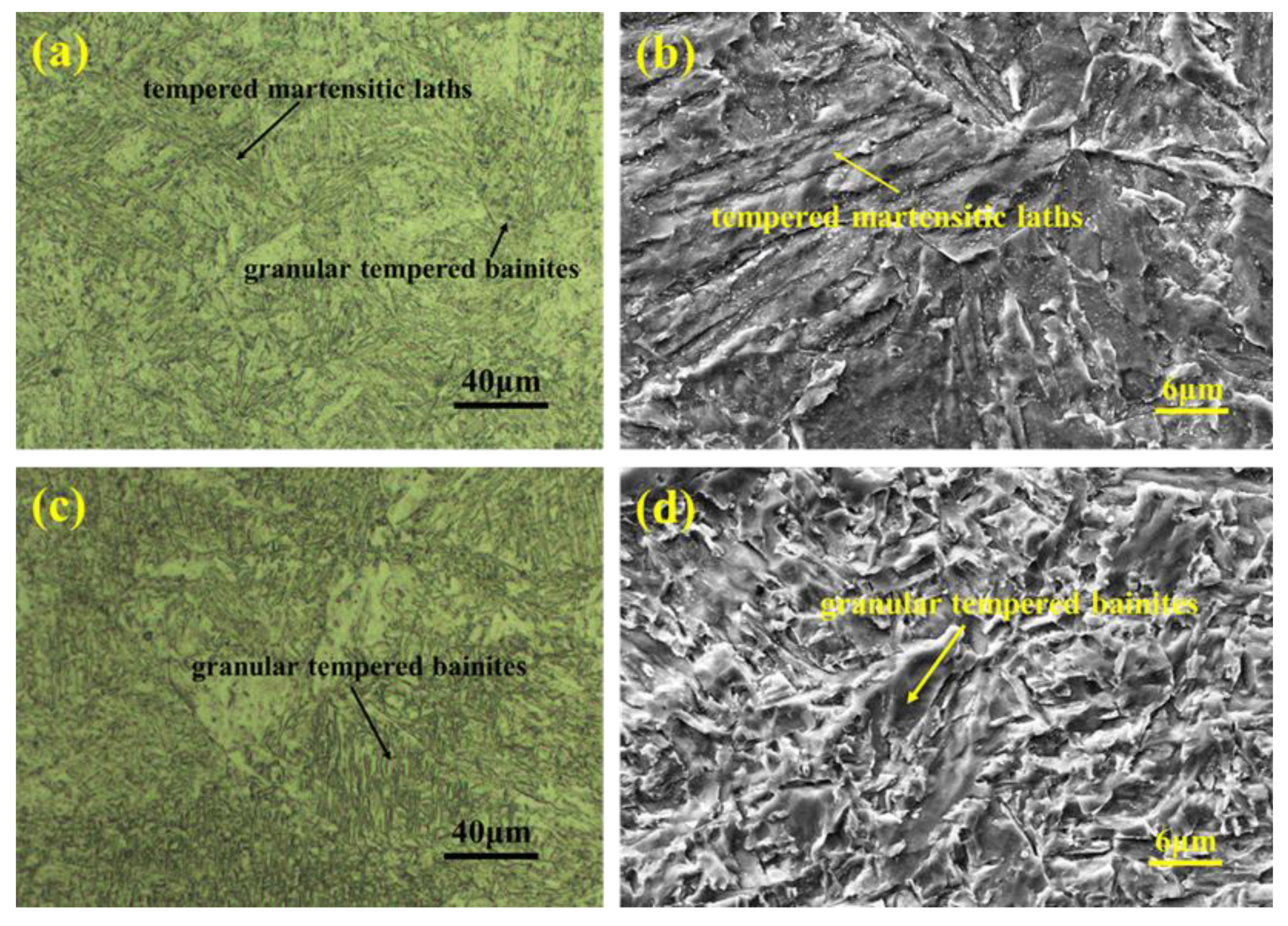
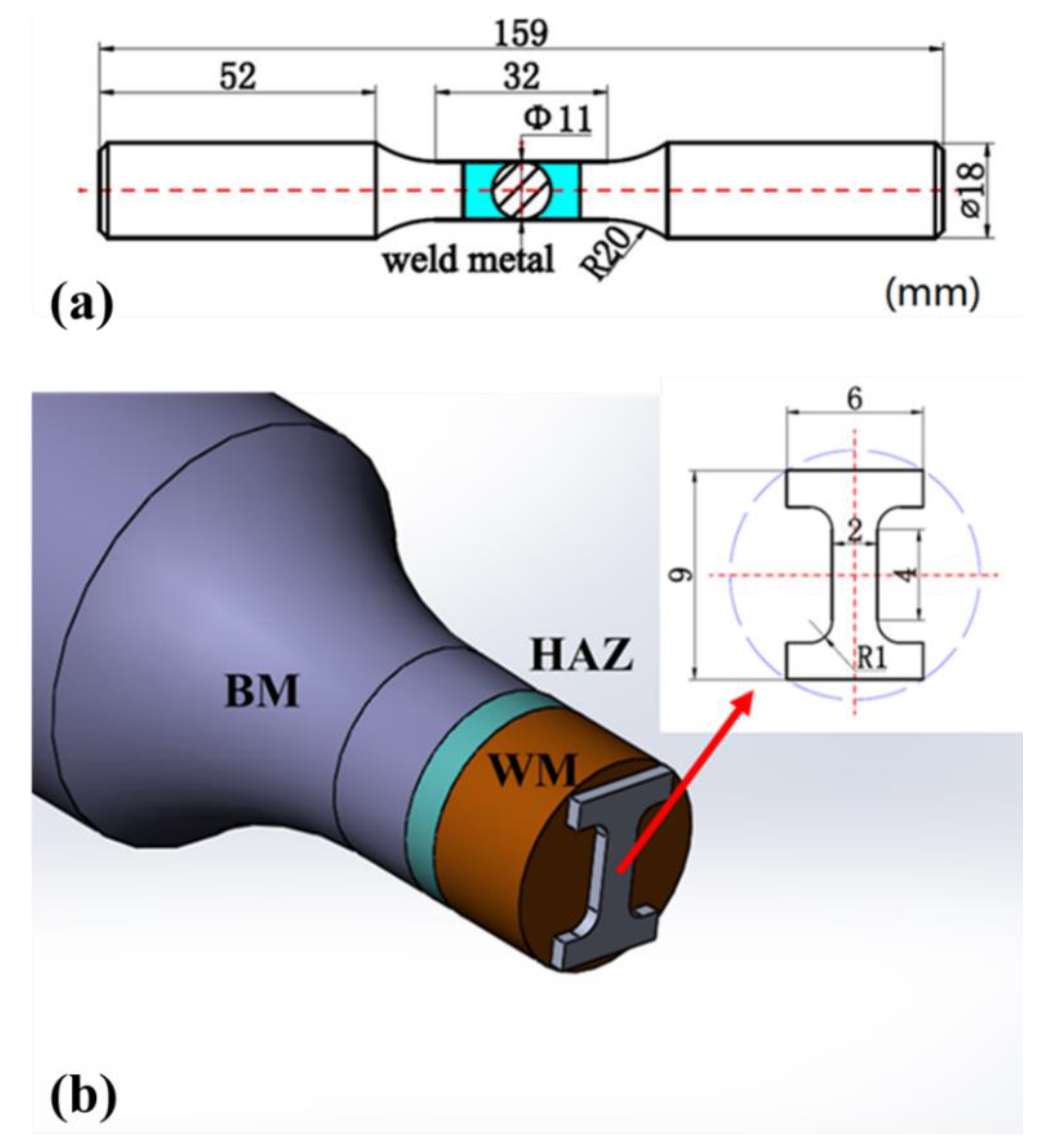
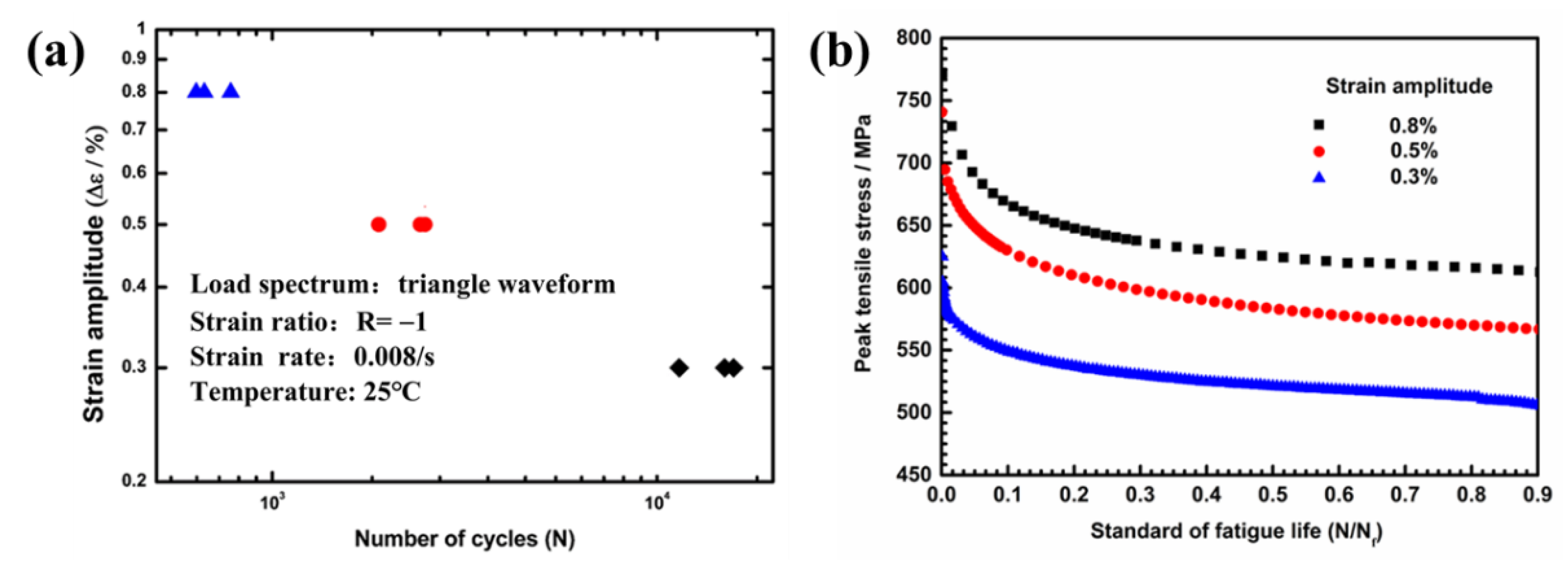
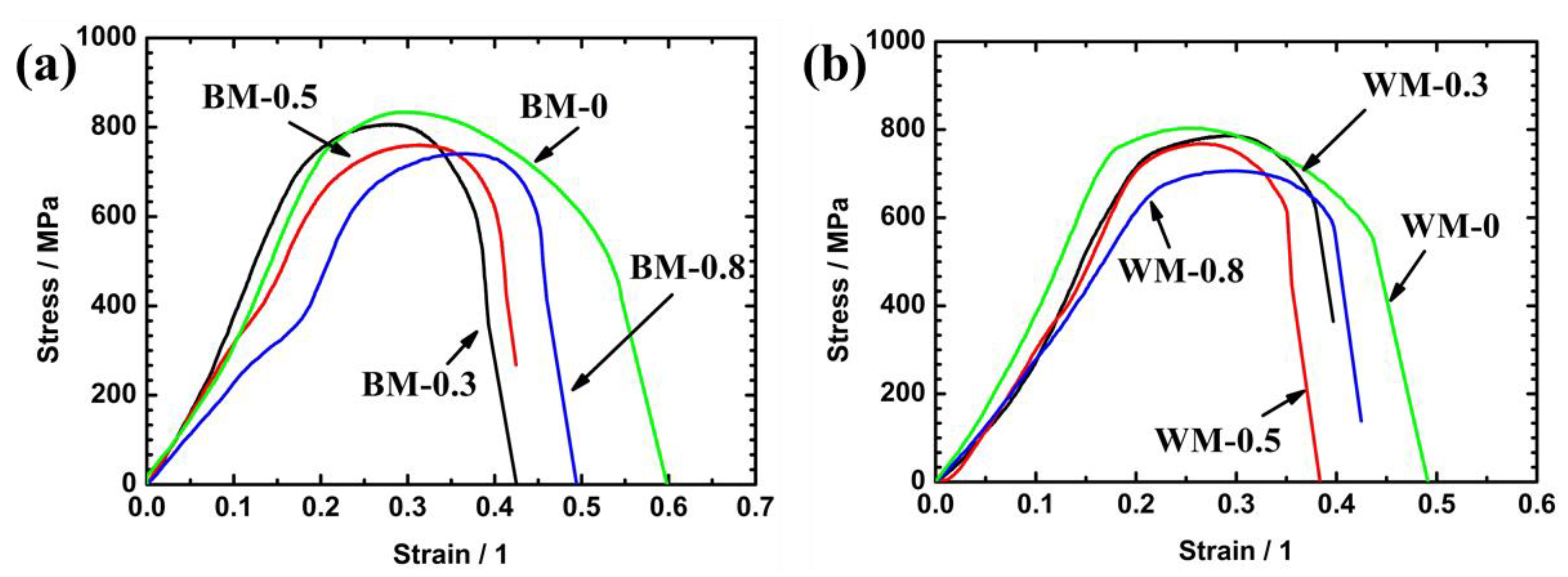
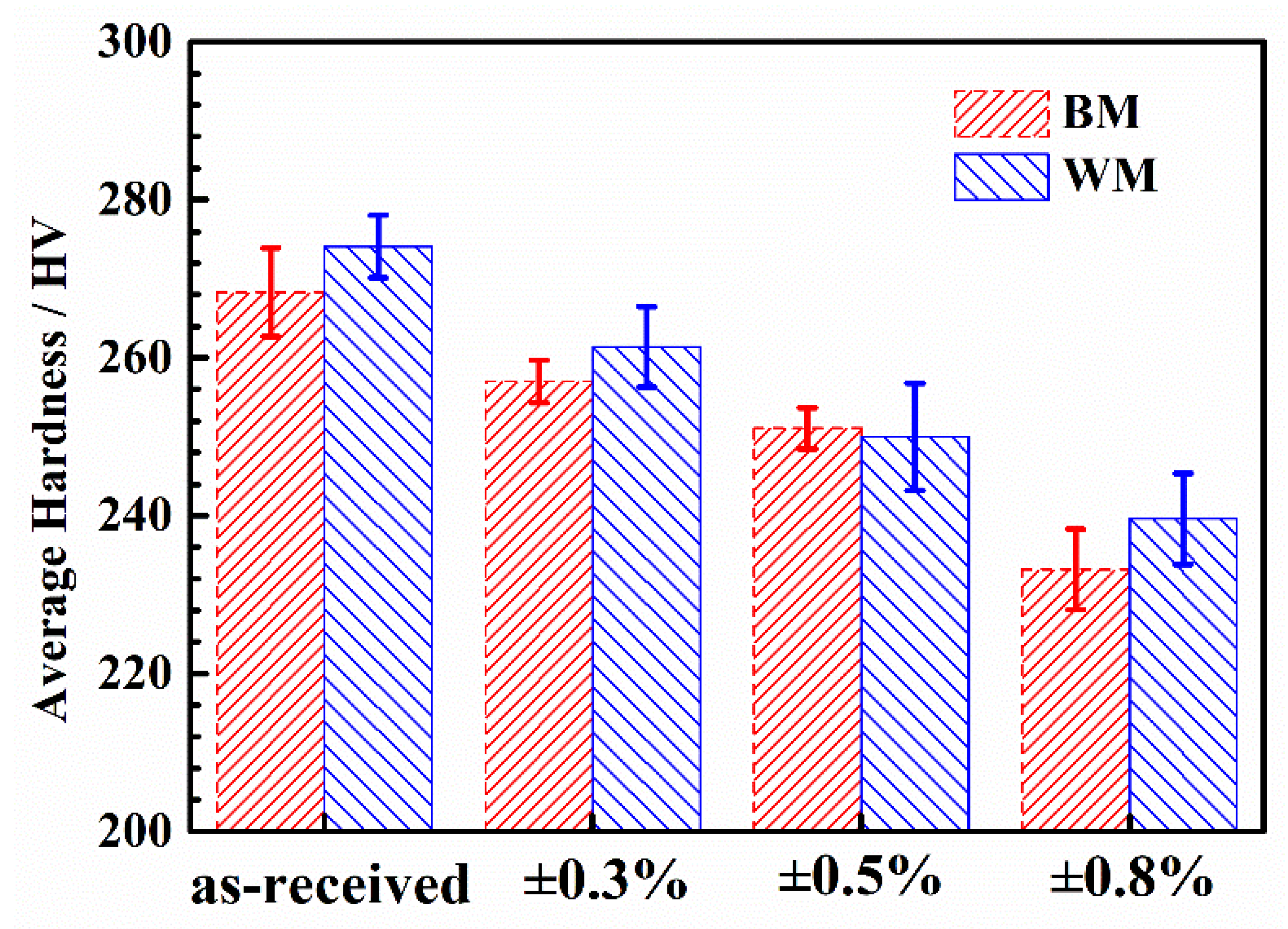
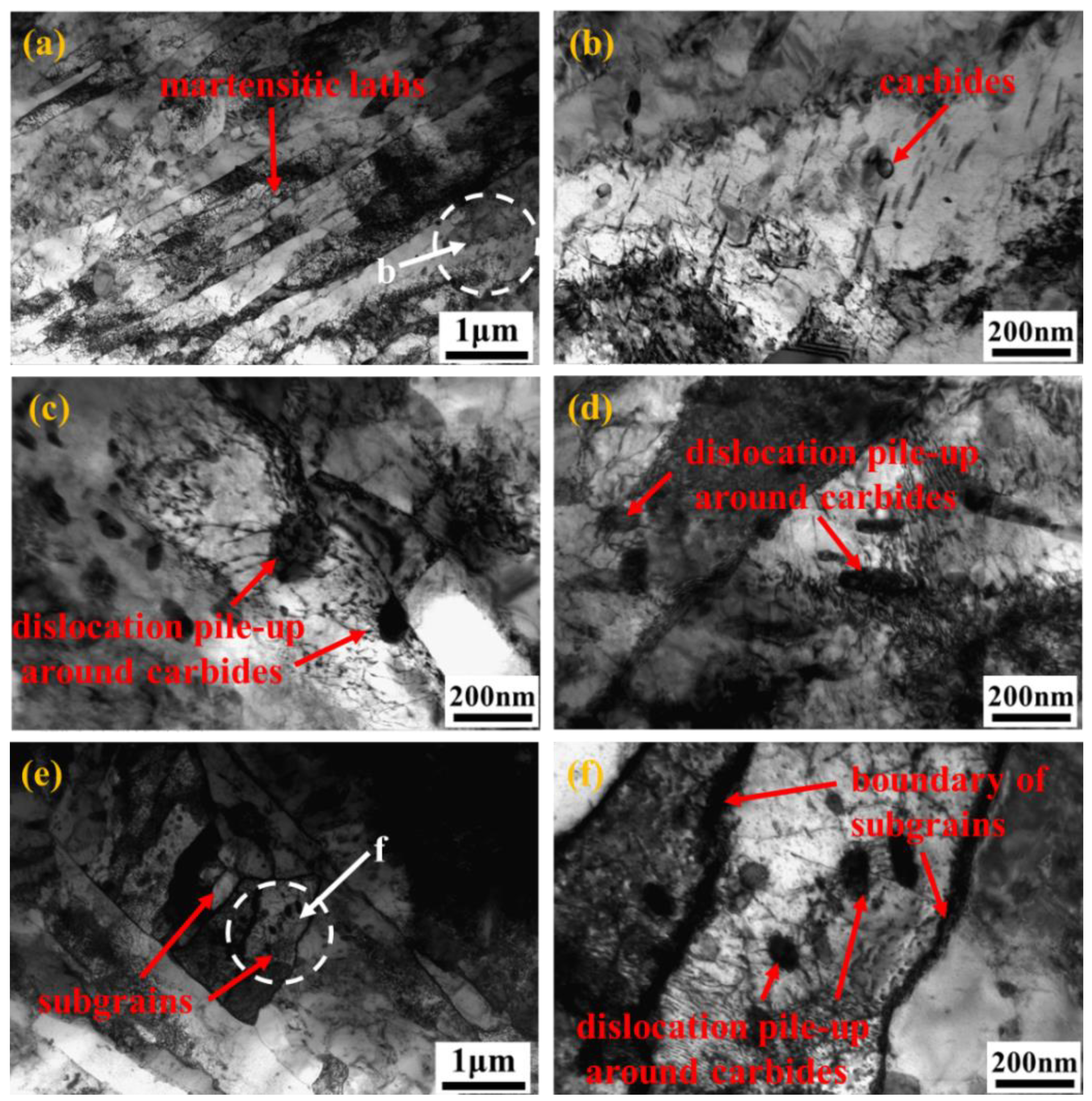

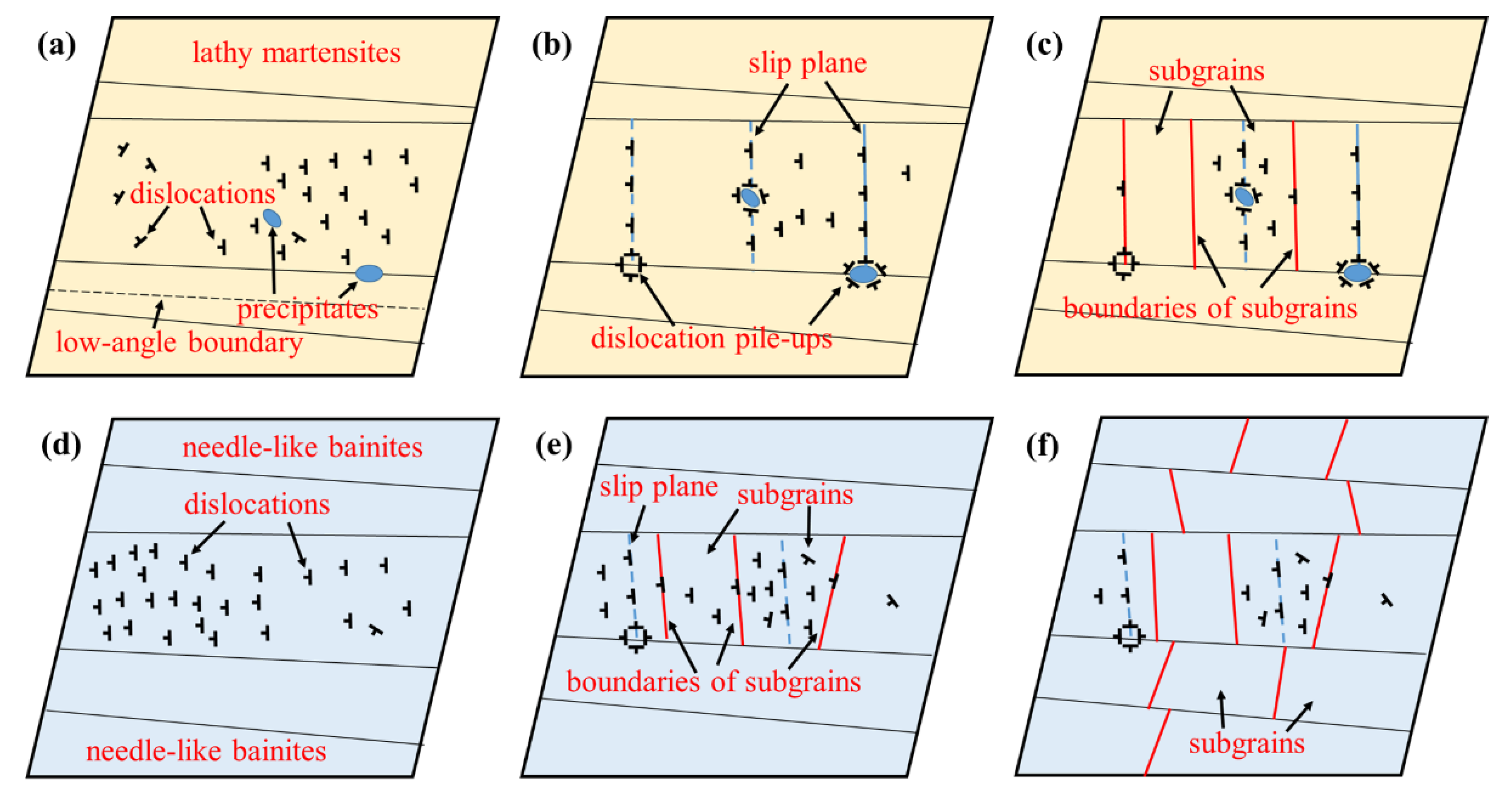
| Zone | C | Si | Mn | P | S | Cr | Ni | Mo | V | Cu | Fe |
|---|---|---|---|---|---|---|---|---|---|---|---|
| BM | 0.22 | 0.10 | 0.21 | 0.01 | 0.01 | 2.3 | 2.2 | 0.7 | 0.1 | 0.05 | Bal. |
| WM | 0.12 | 0.2 | 1.48 | 0.005 | 0.005 | 0.57 | 2.18 | 0.51 | - | - | Bal. |
| Strengths of Zones | as-Received | ±0.3% | ±0.5% | ±0.8% |
|---|---|---|---|---|
| YS of BM | 738.8 ± 12.2 | 680.9 ± 11.6 | 622.5 ± 15.3 | 596.6 ± 12.1 |
| YS of WM | 739.3 ± 14.4 | 721.6 ± 13.2 | 679.4 ± 14.3 | 601.2 ± 12.6 |
| UTS of BM | 837.5 ± 12.6 | 806.8 ± 14.4 | 760.8 ± 13.5 | 740.8 ± 14.6 |
| UTS of WM | 803.9 ± 10.5 | 785.5 ± 11.3 | 748.5 ± 12.1 | 707.8 ± 10.6 |
Publisher’s Note: MDPI stays neutral with regard to jurisdictional claims in published maps and institutional affiliations. |
© 2021 by the authors. Licensee MDPI, Basel, Switzerland. This article is an open access article distributed under the terms and conditions of the Creative Commons Attribution (CC BY) license (https://creativecommons.org/licenses/by/4.0/).
Share and Cite
Weng, S.; Huang, Y.; Zhu, M.; Xuan, F. Microstructural Evolution along the NiCrMoV Steel Welded Joints Induced by Low-Cycle Fatigue Damage. Metals 2021, 11, 811. https://doi.org/10.3390/met11050811
Weng S, Huang Y, Zhu M, Xuan F. Microstructural Evolution along the NiCrMoV Steel Welded Joints Induced by Low-Cycle Fatigue Damage. Metals. 2021; 11(5):811. https://doi.org/10.3390/met11050811
Chicago/Turabian StyleWeng, Shuo, Yuhui Huang, Mingliang Zhu, and Fuzhen Xuan. 2021. "Microstructural Evolution along the NiCrMoV Steel Welded Joints Induced by Low-Cycle Fatigue Damage" Metals 11, no. 5: 811. https://doi.org/10.3390/met11050811
APA StyleWeng, S., Huang, Y., Zhu, M., & Xuan, F. (2021). Microstructural Evolution along the NiCrMoV Steel Welded Joints Induced by Low-Cycle Fatigue Damage. Metals, 11(5), 811. https://doi.org/10.3390/met11050811








